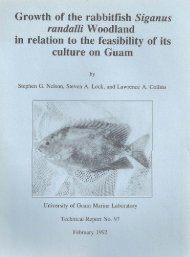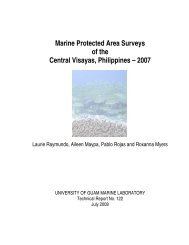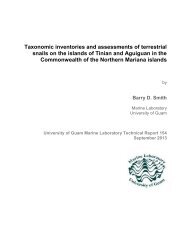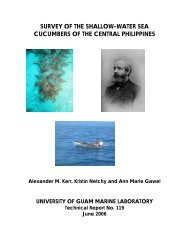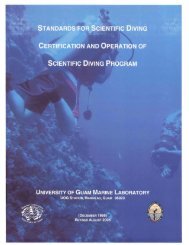MARINE BIOLOGICAL SURVEY OF THE PROPOSED DOCK SITE ...
MARINE BIOLOGICAL SURVEY OF THE PROPOSED DOCK SITE ...
MARINE BIOLOGICAL SURVEY OF THE PROPOSED DOCK SITE ...
You also want an ePaper? Increase the reach of your titles
YUMPU automatically turns print PDFs into web optimized ePapers that Google loves.
6In order to assess the general pattern afwater circulation atthe study site. a patch of fluorescein dye was released at channelmarker A at a depth of 2 meters on March 6, 1977. at 10:02 a.m.This dye patch was tracked for a period of 45 minutes.RESULTS AND DISCUSSIONMarine Plants - A total of 51 species of marine benthic plants(Table 1) was collected or observed in the study site. This comparedfavorable with the 41 species reported previously (Amesbury et al.,1976) at the sewage outfall site off Conitsch Island. Thirty-one ofthe species were common to both sites (Coefficient of Community = 52%).[This value was derived by dividing the number of species common toboth sites by the total number of species present in both sites andmUltiplying by 100 to obtain a percentage value.] None of the algalor seagrass species present at the study site could be considered asendangered or threatened species.The marine benthic flora, quantified within 10-20 m segments,along each of the four transects are presented in Figure 4 in termsof the dominant functional groups, i.e., floristic elements compartmentalizedwith respect to their secondary role in the ecosystem.The four functional groups depicted here are turf (algae usually lessthan 2 cm high), macroalgae (fleshy, usually erect, algae), seagrasses.and the crustose coral-line algae.As seen in Figure 4, the turf community is dominant and oftenserves as the major source of food for herbivorous fishes. Themacroalage and sea-grasses are also conspicuous and serve as coverfor many of the organisms inhabiting this area. In addition, thedecomposed macroalgae and, especially, the decomposed sea-grassesserve as the primary source of food for detritus feeding organisms.The crustose coralline algae, most conspicuous on the upper reefslope, serve primarily as the cementing agent for coral rubble.As mentioned previously, the study site can be divided intofour zones which consist of distinct algal components. The dominantalga in the Boulder-Rubble Zone (N = 50 tosses) was Polysiphoniahowei which formed dark red mats on the vertical walls and covered-----37% of this zone. Other algae quantified here were the blue-greenalgae Microcoleus lyngbyaceus (12% cover) and Brachytrichia quoyi(3% cover). The green alga Neomeris vanbosseae (2% cover) was alsoconspicuous in this zone.Forty-one of the 51 species found in the study site were presentin the Enhalus-Thalassia Zone (N = 105 tosses). The two major seagrassesThalassia hemprichii and Enhalus acoroides were the mostconspicuous component covering 14% and 6%, respectively, of the





